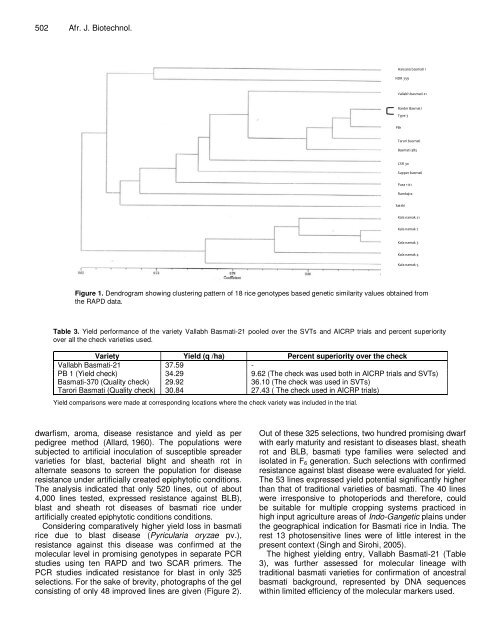Improvement of Basmati rice - Academic Journals
Improvement of Basmati rice - Academic Journals
Improvement of Basmati rice - Academic Journals
Create successful ePaper yourself
Turn your PDF publications into a flip-book with our unique Google optimized e-Paper software.
502 Afr. J. Biotechnol.<br />
Haryana basmati 1<br />
NDR 359<br />
Vallabh basmati 21<br />
Ranbir <strong>Basmati</strong><br />
Type 3<br />
PB1<br />
Tarori basmati<br />
<strong>Basmati</strong>-385<br />
CSR 30<br />
Supper basmati<br />
Pusa 1121<br />
Ramkajra<br />
Satthi<br />
Kala namak z1<br />
Kala namak 2<br />
Kala namak 3<br />
Kala namak 4<br />
Kala namak 5<br />
Figure 1. Dendrogram showing clustering pattern <strong>of</strong> 18 <strong>rice</strong> genotypes based genetic similarity values obtained from<br />
the RAPD data.<br />
Table 3. Yield performance <strong>of</strong> the variety Vallabh <strong>Basmati</strong>-21 pooled over the SVTs and AICRP trials and percent superiority<br />
over all the check varieties used.<br />
Variety Yield (q /ha) Percent superiority over the check<br />
Vallabh <strong>Basmati</strong>-21 37.59 -<br />
PB 1 (Yield check) 34.29 9.62 (The check was used both in AICRP trials and SVTs)<br />
<strong>Basmati</strong>-370 (Quality check) 29.92 36.10 (The check was used in SVTs)<br />
Tarori <strong>Basmati</strong> (Quality check) 30.84 27.43 ( The check used in AICRP trials)<br />
Yield comparisons were made at corresponding locations where the check variety was included in the trial.<br />
dwarfism, aroma, disease resistance and yield as per<br />
pedigree method (Allard, 1960). The populations were<br />
subjected to artificial inoculation <strong>of</strong> susceptible spreader<br />
varieties for blast, bacterial blight and sheath rot in<br />
alternate seasons to screen the population for disease<br />
resistance under artificially created epiphytotic conditions.<br />
The analysis indicated that only 520 lines, out <strong>of</strong> about<br />
4,000 lines tested, expressed resistance against BLB),<br />
blast and sheath rot diseases <strong>of</strong> basmati <strong>rice</strong> under<br />
artificially created epiphytotic conditions conditions.<br />
Considering comparatively higher yield loss in basmati<br />
<strong>rice</strong> due to blast disease (Pyricularia oryzae pv.),<br />
resistance against this disease was confirmed at the<br />
molecular level in promising genotypes in separate PCR<br />
studies using ten RAPD and two SCAR primers. The<br />
PCR studies indicated resistance for blast in only 325<br />
selections. For the sake <strong>of</strong> brevity, photographs <strong>of</strong> the gel<br />
consisting <strong>of</strong> only 48 improved lines are given (Figure 2).<br />
Out <strong>of</strong> these 325 selections, two hundred promising dwarf<br />
with early maturity and resistant to diseases blast, sheath<br />
rot and BLB, basmati type families were selected and<br />
isolated in F6 generation. Such selections with confirmed<br />
resistance against blast disease were evaluated for yield.<br />
The 53 lines expressed yield potential significantly higher<br />
than that <strong>of</strong> traditional varieties <strong>of</strong> basmati. The 40 lines<br />
were irresponsive to photoperiods and therefore, could<br />
be suitable for multiple cropping systems practiced in<br />
high input agriculture areas <strong>of</strong> Indo-Gangetic plains under<br />
the geographical indication for <strong>Basmati</strong> <strong>rice</strong> in India. The<br />
rest 13 photosensitive lines were <strong>of</strong> little interest in the<br />
present context (Singh and Sirohi, 2005).<br />
The highest yielding entry, Vallabh <strong>Basmati</strong>-21 (Table<br />
3), was further assessed for molecular lineage with<br />
traditional basmati varieties for confirmation <strong>of</strong> ancestral<br />
basmati background, represented by DNA sequences<br />
within limited efficiency <strong>of</strong> the molecular markers used.

















